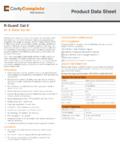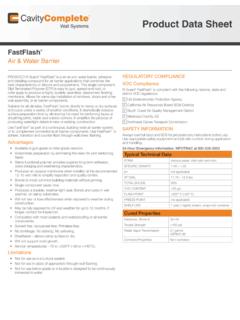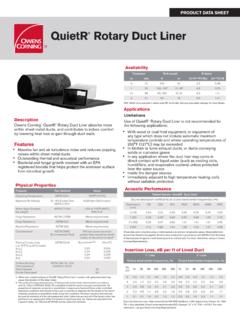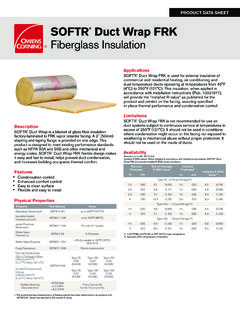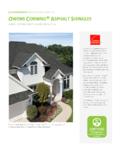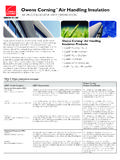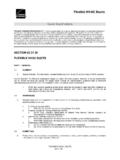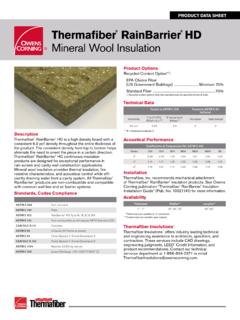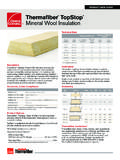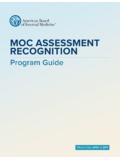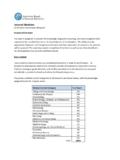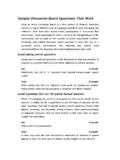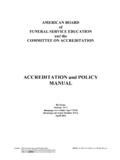Transcription of PROJECT ENGINEER RESPONSIBILITY - Owens Corning
1 DUCT INSULATION 23 07 13 - 1 Duct Insulation - QuietR Duct board PROJECT ENGINEER RESPONSIBILITY : This is a general specification guide, intended to be used by experienced construction professionals, in conjunction with good construction practice and professional judgment. This guide is to aid in the creatio n of a complete building specification that is to be fully reviewed and edited by the ENGINEER . Sectio ns of this guide sho uld be included, edited, or omitted based on the requirements of a specific PROJECT . It is the respo nsibility of both the specifier and the purchaser to determine if a product or system is suitable for its intended use. Neither Owens Corning , nor any of its subsidiary or affiliated com-panies, assume any respo nsibility for the content of this specification guide relative to actual projects and specifically disclaim any and all liability for any errors or omissions in design, detail, structural capability, attachment details, shop drawings or other co nstruc-tion related details, whether based upo n the information provided by Owens Corning or otherwise.
2 SECTION 23 07 13 DUCT INSULATION PART 1 - GENERAL SUMMARY A. Section Includes: Provide fibrous glass duct board and closure system for residential and commercial HVAC rigid duct systems. Note to Specifier: The following temperature ranges are typical for these systems. However, if PROJECT requirements call for service temperatures outside the ranges listed, consult the manufacturer's published data to determine operating temperature limitations of the insulation product or products under consideration. 1. HVAC duct systems operating at internal air velocities not exceeding rated duct liner limitations as listed below, and internal air temperatures between 40 F (4 C) and 250 F (121 C) and air velocities to 6,000 fpm ( m/s). REFERENCES A. Materials shall meet the requirements of one or more of the following specifications as applicable to the specific product or end use: 1.
3 Underwriters Laboratories (UL): a. UL 181, Standard for Factory-Made Air Ducts and Air Connectors. b. UL 181A, Standard for Closure Systems for Use with Rigid Air Ducts. c. UL 181B, Standard for Closure Systems for Use with Flexible Air Ducts and Air Connectors. d. UL 723, Test for Surface Burning Characteristics of Building Materials. 2. American Society for Testing of Materials (ASTM): a. ASTM E84, Standard Test Method for Surface Burning Characteristics of Building Materials. 3. National Fire Protection Association (NFPA): a. NFPA 90A, Standard for the Installation of Air-Conditioning and Ventilating Systems. b. NFPA 90B, Standard for the Installation of Warm Air Heating and Air-Conditioning Systems. SUBMITTALS A. Product Data: Submit product characteristics, performance criteria, and limitations, including installation instructions, for each type of product indicated.
4 B. Sustainable Design Submittals: Submit manufacturer s sustainable design certifications as specified. DUCT INSULATION 23 07 13 - 2 Duct Insulation - QuietR Duct board DELIVERY AND STORAGE OF MATERIALS A. Delivery: Deliver materials in manufacturer s original packaging. B. Storage: Store and protect products in accordance with manufacturer s instructions. Store in a dry indoors location. Protect insulation materials from moisture and soiling. C. Do not install insulation that has been damaged or wet. Remove it from jobsite. PART 2 - PRODUCTS MANUFACTURER A. Owens Corning Insulating Systems, LLC, Toledo, OH 43659; DUCT board A. General: 1. Duct board : Rigid, resin bonded fibrous glass board with a damage-resistant, flame retardant, reinforced aluminum foil (FRK) facing and a veil faced airstream surface.
5 2. Owens Corning QuietR Duct board insulation is not known to contain penta-, octa, or deca-brominated diphenyl flame retardant substances, such as deca-Bromine (deca-BDE). B. Certifications: 1. QuietR Duct board is GREENGUARD Indoor Air Quality Certified . 2. QuietR Duct board has achieved GREENGUARD Gold Certification for dimensions up to and including 1 thickness. 3. QuietR Duct board is certified by SCS Global Services to contain a minimum of 53% recycled glass content, 31% pre-consumer and 22% post-consumer. 4. All duct board products are UL listed and labeled. C. Acceptable Product: Owens Corning QuietR Duct board . a. Type 475: , 1 in (25mm) thick, NRC , density pcf. b. Type 800: , 1-1/2 in (38mm) thick, NRC , density pcf. c. Type 1400: , 2 in (51mm) thick, NRC , density pcf.
6 ACCESSORY MATERIALS A. Accessories: Provide accessories per duct board system manufacturer s recommendations, including the following: 1. Adhesive Tape: UL 181A, Part I (P), pressure sensitive type or Part II (H) heat activated type. 2. Fabric Closure: UL 181A, Part III (M), mastic and glass fabric type. 3. Staples: Outward flaring types, 1/2 in min size. DUCT INSULATION 23 07 13 - 3 Duct Insulation - QuietR Duct board PART 3 - EXECUTION EXAMINATION A. Verify that materials and accessories can be installed in accordance with Contract Documents and material manufacturers' recommendations. B. Verify, by inspecting product labeling, submittal data, and/or certifications which may accompany the shipments, that materials and accessories to be installed on the PROJECT comply with applicable specifications and standards and meet specified thermal and physical properties.
7 C. Before starting work under this section, carefully inspect the site and installed work of other trades and verify that such work is complete to the point where installation of materials and accessories under this section can begin. SAFETY PRECAUTIONS A. Insulation contractor's employees shall be properly protected during installation of insulation. Protection shall include proper attire when handling and applying insulation materials, and shall include, but not be limited to, disposable dust respirators, gloves, hard hats, and eye protection. INSTALLATION A. Install duct systems in accordance with the North American Insulation Manufacturers Association (NAIMA) Fibrous Glass Duct Construction Standards. B. Staple longitudinal and circumferential joints at 2 in m ax.
8 C. Seal ducts with one of the following closure methods: 1. Pressure Sensitive Tape: Clean surface prior to applying tape, as recommended by tape manufacturer. Apply pressure sensitive tape firmly and seal with hot iron when ambient temperature is below 50F. 2. Heat-Activated Tape: Clean surface prior to applying tape, as recommended by tape manufacturer. Apply heat-activated tape firmly and seal with hot iron. 3. Mastic and Glass Fabric: Brush mastic onto joint, embed glass fabric in mastic, and brush second coat of mastic over fabric until completely filled. FIELD QUALITY ASSURANCE A. Upon completion of insulation work and before operation is to commence, visually inspect the work and verify that it has been correctly installed.
9 B. Open all system dampers and turn on fans to blow all scraps and other loose pieces of material out of the duct system. Allow for a means of removal of such material. C. Check the duct system to ensure that there are no air leaks through joints. PROTECTION A. Replace damaged insulation, which cannot be satisfactorily repaired, including insulation with duct liner damage and moisture-saturated insulation. DUCT INSULATION 23 07 13 - 4 Duct Insulation - QuietR Duct board B. The insulation contractor shall advise the general and/or the mechanical contractor as to requirements for protection of the insulation work during the remainder of the construction period, to avoid damage and deterioration of the finished insulation work. END OF SECTION Pub. No. 10019394 2014 Owens Corning .
10 All Rights Reserved.

